Schlumberger Sema TALWCNMIU1 Water Meter Spread Spectrum Transmitter User Manual
Schlumberger Sema Water Meter Spread Spectrum Transmitter Users Manual
Users Manual

15956 Rev. 0
12/10/98 3:36 PM
1
SECTION 1
INTRODUCTION
ABOUT THIS MANUAL
This instruction manual explains the installation, operation, and maintenance of the
Schlumberger Wall Meter Interface Unit1(MIU1). Schlumberger urges you to read the entire
manual before attempting installation, tests, operations, or maintenance.
Section 1 Introduction -This section describes the organization of this manual, provides
a product description, operations overview, and product specifications.
Section 2 Installation -This section describes storage and unpacking instructions, preliminary
tests, tools and materials, site selection, and installation.
Section 3 Operating Instructions -This section describes controls and indicators, application of
power, power ON/OFF procedures, operating procedures, and any special procedures.
Section 4 Theory Of Operation -This section explains how the product works.
Section 5 Testing And Maintenance -This section explains how to test, troubleshoot, and
maintain the product.
Section 6 Replacement Parts, Schematics, And Drawings -This section provides part numbers for
replacement parts, and any applicable schematic and block diagrams.
Section G Glossary
Index
FCC REGULATORY NOTICE

15956 Rev. 0
12/10/98 3:36 PM
2
PRODUCT DESCRIPTION
The Wall Meter Interface Unit1(Wall MIU1 or MIU1) by Schlumberger, is a compact electronic
device that collects meter reading data from an encoder register and transmits the data for
collection to a nearby line of sight CellNet MicroCell Controller(MCC) fixed network. This
product is based on CellNet BAMM RF design. This is a one way transmission to MCC. Since
the MIU can be mounted as much as 500 feet from the encoder register, (See Table 1.5 for
system compatible encoders and maximum installation cable length/distance.), optimum
broadcast signal strength is obtainable, insuring a high percentage of accurate. The MIU also
meets FCC regulations part 15.247, allowing higher output power and greater range. The MIU
uses direct sequence spread-spectrum technology to avoid RF interference and enhance security.
• Protects utility liability by increasing meter reader safety.
•Requires no field programming.
• Economizes manhours needed to collect and process meter reading
data, thereby increasing utility profits.
Figure 1.1 Wall MIU
OPERATIONS OVERVIEW
The Wall MIU1 collects meter readings from the encoder register on an hourly basis and
transmits the information every fifteen minutes. This redundant transmit of the same data four
times an hour increases the greater reliability of the data to be received the fixed network MCC.
1-4
SPECIFICATIONS
Electrical Specifications
Transmitter Specifications
Environmental Conditions
Encoder Register Interface
Table 1.2 Electrical Specifications
Battery 3.6V D size Lithium
Transmit Period Every 15 min
Register Read Period Once an hour
Table 1.3 Transmitter Specifications
Transmitter Channels 1
Channel Frequency 902-928 MHz
FCC Verification Part 15.247

15956 Rev. 0
12/10/98 3:36 PM
3
Table 1.4 Environmental Conditions
Operating Temperature -22° to 149°F (-30° to 65°C)
Storage Temperature -22° to 149°F (-30° to 65°C)
Operating Humidity 0 to 95% Condensing
Table 1.5 Encoder Register Interface
Encoder Register Maximum Cable Length
Schlumberger PRO-READ* 500 feet (152 meters)
* Meets manufacturers’ published specification for wire length
between encoder and remote receptacle.
Dimensions and Weight
Table 1.6 Dimensions and Weight
Dimensions Refer to following figures
Weight approximately 1 LB (450 grams.)

15956 Rev. 0
12/10/98 3:36 PM
4
SECTION 2
INSTALLATION
This section describes storage and unpacking instructions, preliminary tests, tools and materials,
site selection, and installation.
STORAGE
Inspect shipping containers for damage upon receipt and inspect contents of any damaged cartons
prior to storage. Store the cartons in a clean, dry environment. The temperature should remain
between -22° and 149°F (-30° and 65°C). Keep in mind that the Wall MIU1 has an internal
battery. Storage for more than one year, of the Wall MIU1, may affect product life. Be sure to
use a first-in first-out inventory control system.
UNPACKING
As with all precision electronic instruments, the Wall MIU1 should be handled with care;
however, special handling is unnecessary. After unpacking the MIU, inspect it for damage. If the
MIU appears to be damaged, or proves to be defective upon installation, notify your
Schlumberger Sales Representative. If the MIU requires reshipment, use the original cardboard
box and packing material.
PRELIMINARY TESTS
The Wall MIU1 does not require any tests or programming prior to installation.
TOOLS AND MATERIALS
Tables 2.1 and 2.2 show the recommended tools and materials you may need to successfully
install the Wall MIU1 or to replace the MIU’s internal Battery. Note that some items may not
apply to your specific installation or the list may not contain all required tools or materials.
Table 2.1 Recommended Tools
Item Description/
Recommendation Use
Tool kit contains standard tools
including:
• Assorted screwdrivers
• Needle-nose pliers
• Wire stripper
Diagonal cutters
• Electrician’s knife
Hammer
Various installation procedures

15956 Rev. 0
12/10/98 3:36 PM
5
Magnet 6 lb. force activating the MIU
Table 2.2 Recommended Materials
Item Description/
Recommendation Use
Cable Solid 3 conductor, #22 AWG
(black/green/red)
Connecting MIU to encoder register
Moisture protection
compound
Dow Corning #4 or
GE Novaguard GB24 ®
Covering exposed wires and Terminal
Screws on register and MIU
Scotchloks ® Splicing three-conductor cables
Gel-caps ® Splicing replacement battery wires
Site Work Order Documentation provided by
your utility
Receiving and recording information
about the work site

15956 Rev. 0
12/10/98 3:36 PM
6
INSTALLATION
Safety and Preliminary Checks
Observe the following safety and preliminary checks before and during each installation:
• Verify that you are at the location specified on the Site Work Order.
• Verify that the site is safe for you and your equipment.
• Notify the customer of your presence and tell the customer that you will need access to the
water meter.
• If the Site Work Order does not have an MIU ID number on it, write in the ID number of the
MIU you are about to install. If the Site Work Order already has a MIU ID number on it, verify
that it matches the ID number on the MIU you are about to install.
Note: • Always follow your company’s safety practices and installation guidelines when
installing an MIU.
• Never perform an installation during a lightning storm or under
excessively wet conditions.
• Use only approved climbing equipment.
Site Selection
The Wall MIU1 should be installed and operated in an environment where the temperature stays
between -22° and 149°F (-30° and 65°C). Installation and operation in moderate temperatures
increases reliability and product life.
Follow these guidelines when selecting a location to install the Wall MIU1:
• For best results, Schlumberger recommends mounting the MIU on the outside of the building
and in a location that provides a direct line-of-sight to the path of the meter reading device.
• For best results, Schlumberger recommends, the MIU be installed approximately five feet
above the ground.
• The MIU must be installed in a vertical and upright position.
• The preferred mounting surface for the MIU is a flat wall, but it can also be mounted to a pipe.
• The selected location should be clear of all obstructions.
• Avoid installing the MIU behind metal fences or walls.
. RF line of sight must be verified to a nearby MCC for data strength.
• The maximum cable length between the encoder register and MIU depends on the register’s
manufacturer and model. Refer to Table 2.3 for maximum
cable lengths.
Table 2.3 Maximum Cable Lengths
Encoder Register Maximum Cable Length

15956 Rev. 0
12/10/98 3:36 PM
7
Schlumberger PRO-READ ® * 500 feet (152 meters)
* Meets manufacturers’ published specification for wire length
between encoder and remote receptacles.
Verifying/Preparing the Encoder Register
This Wall MIU1 is designed for use with Schlumberger ProRead Encoder Rev. E, D and C.
Before installing an MIU, the encoder register must be correctly wired and/or programmed to
work with the MIU.
If a three-conductor cable is not connected to the encoder register, it will have to be connected
and run to the outside of the building. Refer to Steps 1 - 9 in this procedure for that information.
If a three-conductor cable is already connected to the encoder register and available on the
outside of the building, the wire color/terminal screw connections on the encoder register will
have to be verified. Refer to Step 4 in this procedure for that information.
If a three-conductor cable already connects a Pro-Read ® encoder register to a wall-mounted
receptacle, the Pro-Read ® must be programmed for three-wire mode. Refer to Step 4 in this
procedure for that information.
If a three-conductor cable already connects a Pro-Read ® encoder register to a wall-mounted
receptacle, the cable may have to be extended to a location that is appropriate for mounting the
MIU. Refer to the section “Splicing a Three-Conductor Cable.”
1 Remove the terminal screw cover from the encoder register.
2 Strip off 3/4" from the jacket of the three-conductor cable.
3 Strip off 1/2" of insulation from each of the three wires.
4 Connect one wire to each terminal screw as described in Table 2.4 and shown
in Figures 2.4 and 2.5.
Table 2.4 Encoder Register Interface
Encoder Register Wire Color / Encoder Terminal
Schlumberger Pro-Read ® Black / B Green / G Red / R
Note: If the MIU will be connected to a Pro-Read ® encoder register, the Pro-Read ® must be
programmed for three-wire mode using a Pro-Read ® programmer and its ten-digit TDI format.
Do this through the Pro-Read ® receptacle before removing the receptacle. For more information
about Pro-Read ® programmers, contact your Schlumberger sales representative.
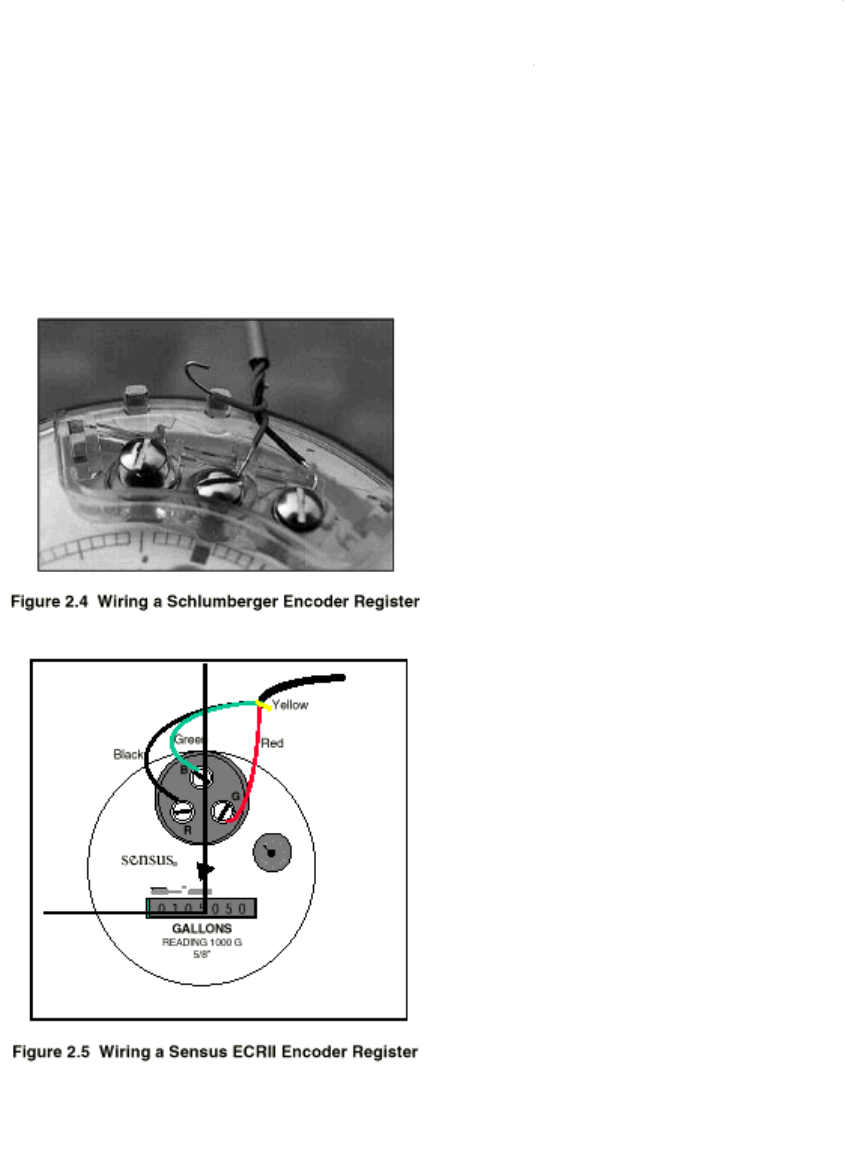
15956 Rev. 0
12/10/98 3:36 PM
8
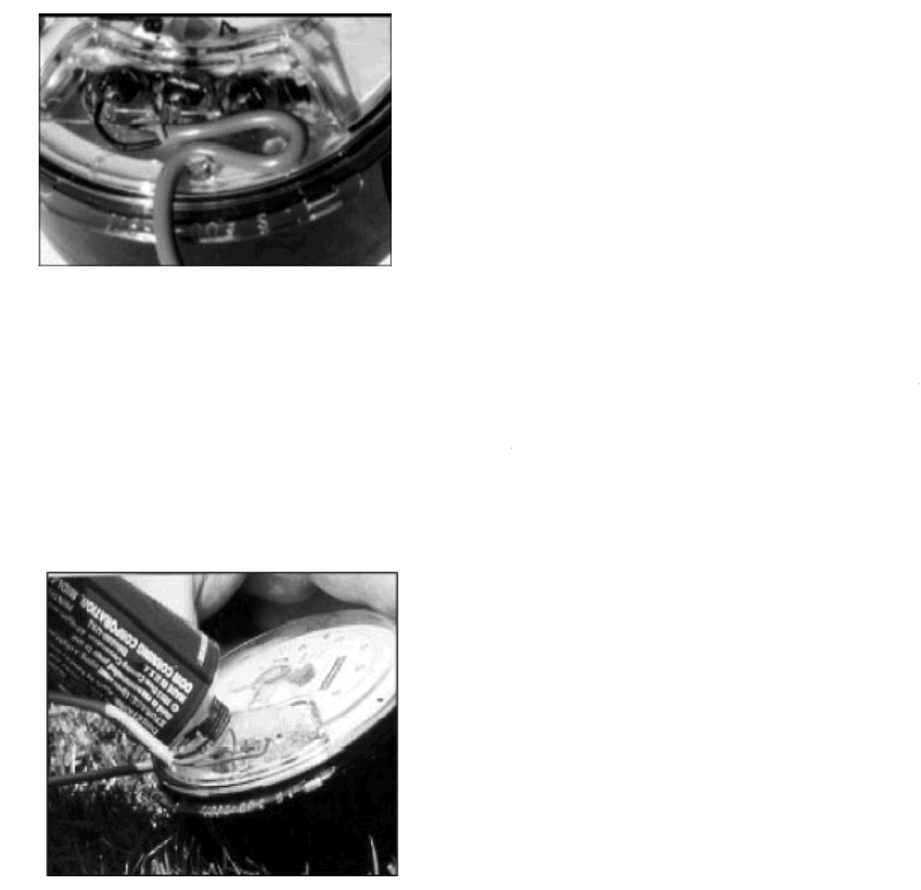
15956 Rev. 0
12/10/98 3:36 PM
9
2-7
5 Thread the cable around the strain relief posts (Figure 2.6).
Figure 2.6 Cable Threaded Around Strain Relief Posts
6 Use a generous amount of moisture protection compound (Dow Corning #4 ®
or GE Novaguard GB24 ® ) to completely cover the terminal screws and
exposed wire (Figure 2.7).
Figure 2.7 Installing Moisture Protection Compound
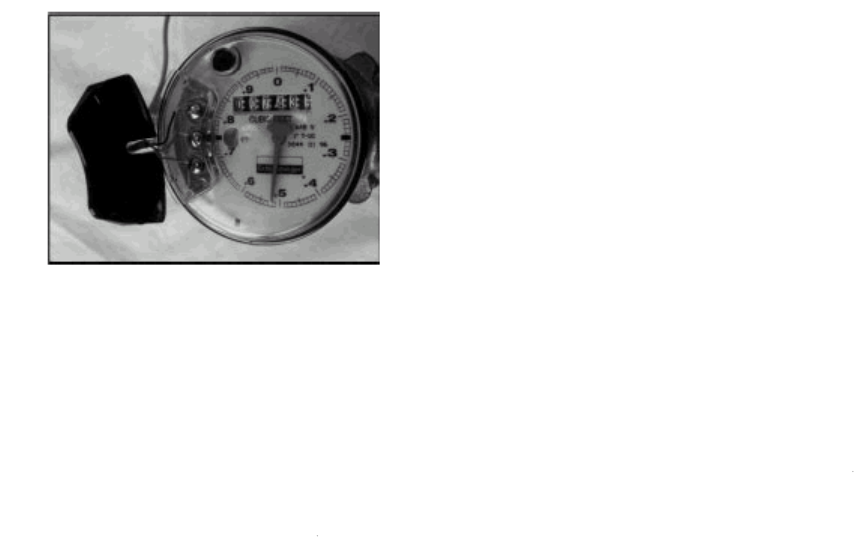
15956 Rev. 0
12/10/98 3:36 PM
10
7 Align the cable with the notch in the terminal screw cover and snap the cover
onto the encoder register (Figure 2.8).
Figure 2.8 Covering the Terminal Screws
8 Run the cable from the MIU installation point to the encoder register, fastening
it securely as necessary.
9 If necessary, drill a hole in an appropriate location and run the cable through
the hole to the outside of the building.
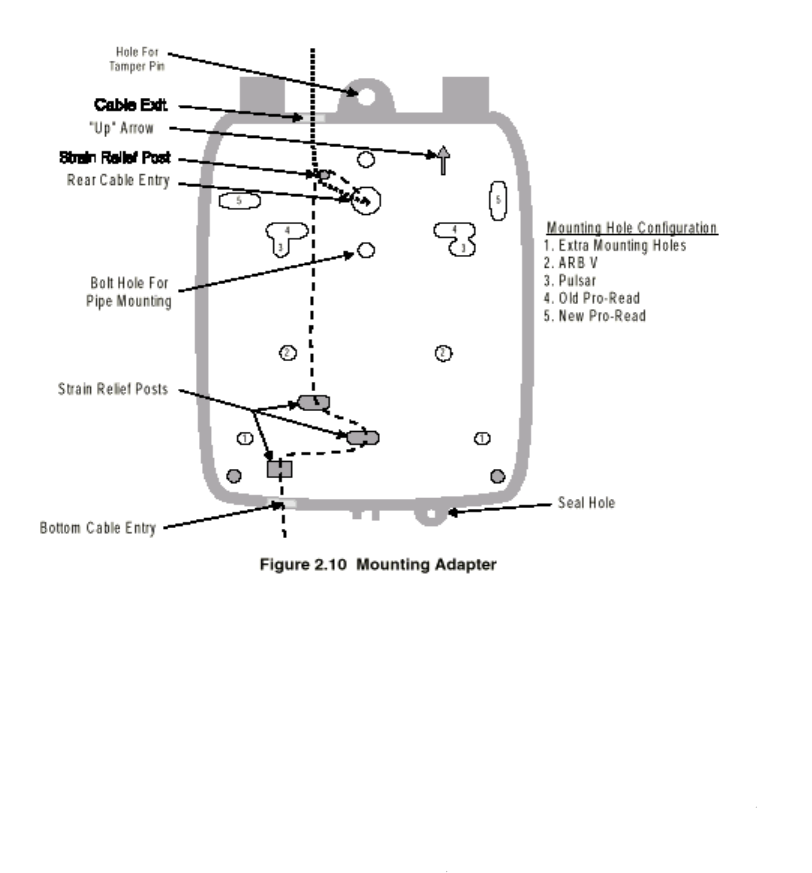
15956 Rev. 0
12/10/98 3:36 PM
11
15956 Rev. 0
12/10/98 3:36 PM
12

15956 Rev. 0
12/10/98 3:36 PM
13
Installing the MIU
Please read and comply with all of the information in “Verifying/Preparing the Encoder
Register” before continuing with this section, “Installing the MIU.”
Please read this entire section before attempting an MIU installation:
1 Select a location for the MIU that meets the recommendations in “Site Selection.”
2 Fastening the three-conductor cable securely as necessary, run it from where
it exits the building to where the MIU will be mounted.
3 Unscrew the bolt holding the Main Housing to the Mounting Adapter.
4 Release the Clip at the bottom of the MIU and separate the Main Housing from the Mounting
Adapter (Figure 2.9).
5 Based on Figure 2.10 and the particular requirements of the installation site, decide how you
will install the MIU.
Figure 2.10 Mounting Adapter
Note: A variety of holes in the Mounting Adapter allows for a quick and easy installation:
• When the cable will enter through the rear of the MIU, rather than the bottom of the MIU, use
the indicated hole to enter the cable.
• When the MIU will replace a receptacle, using the correct holes allows use the receptacle’s
original mounting holes.
• When the MIU will be mounted to a pipe, use the indicated hole to bolt the Mounting Adapter
to a pipe clamp.
6 With the Mounting Adapter in the desired position and the Arrow pointing up, screw the
Mounting Adapter to the wall.
7 If the cable was not routed through the back of the Mounting Adapter before it
was screwed to the wall, route the cable through the notch at the bottom of the
Mounting Adapter (Figure 2.11).
8 To provide maximum strain relief, wrap the cable around the Strain Relief
Posts (Figures 2.11 and 2.12).
6 With the Mounting Adapter in the desired position and the Arrow pointing up,
screw the Mounting Adapter to the wall.
7 If the cable was not routed through the back of the Mounting Adapter before it
was screwed to the wall, route the cable through the notch at the bottom of the
Mounting Adapter (Figure 2.11).
8 To provide maximum strain relief, wrap the cable around the Strain Relief
Posts (Figures 2.11 and 2.12).
9 Route the cable through the notch in the top of the Mounting Adapter. Make

15956 Rev. 0
12/10/98 3:36 PM
14
sure the cable stays in the notch during the installation of the Main Housing
(Figures 2.11 and 2.12).
10 Install the Main Housing by mating the hinge elements at the top of the Main
Housing to the hinge elements at the top of the Mounting Adapter and then
lowering the Main Housing until is snaps into place.
11 Connect the appropriate color wire to each Terminal Screw (B = Black,
G = Green, R = Red).
12 Follow the steps in “Testing the Installation.”
Testing the Installation
Refer to Section 5, “Testing And Maintenance.”
Completing the Installation
After verifying that the MIU is working correctly, follow these steps to complete the installation:
1 Install the bolt that holds the Main Housing to the Mounting Adapter.
2 Use a generous amount of moisture protection compound (Dow Corning #4 or
GE Novaguard GB24) to completely cover the Terminal Screws and exposed wires.
3 Slide the Terminal Cover onto the Main Housing. Make sure the Terminal Cover is seated
properly and the cable is fitted into the notch at the top of the Terminal Cover.
4 Install the Tamper Pin into the Terminal Screw Cover.
5 Install a seal wire or seal clip through the Seal Holes at the bottom of the Main Housing.
6 Verify that the requirements of the Site Work Order have been met and that you have recorded
all required information.
7 Clean up the installation site before leaving.
Splicing A Three-Conductor Cable
Splicing three-conductor cables together should be avoided whenever possible. However, if an
existing Pro-Read ® wall receptacle is not in an appropriate location for replacement by an MIU,
it may be necessary to splice the cable and extend it to an appropriate location.
Follow these steps to splice a three-conductor cable:
1 Remove the receptacle from the wall.
2 Remove the wires from the receptacle.
3 Cut away the exposed copper from each wire.
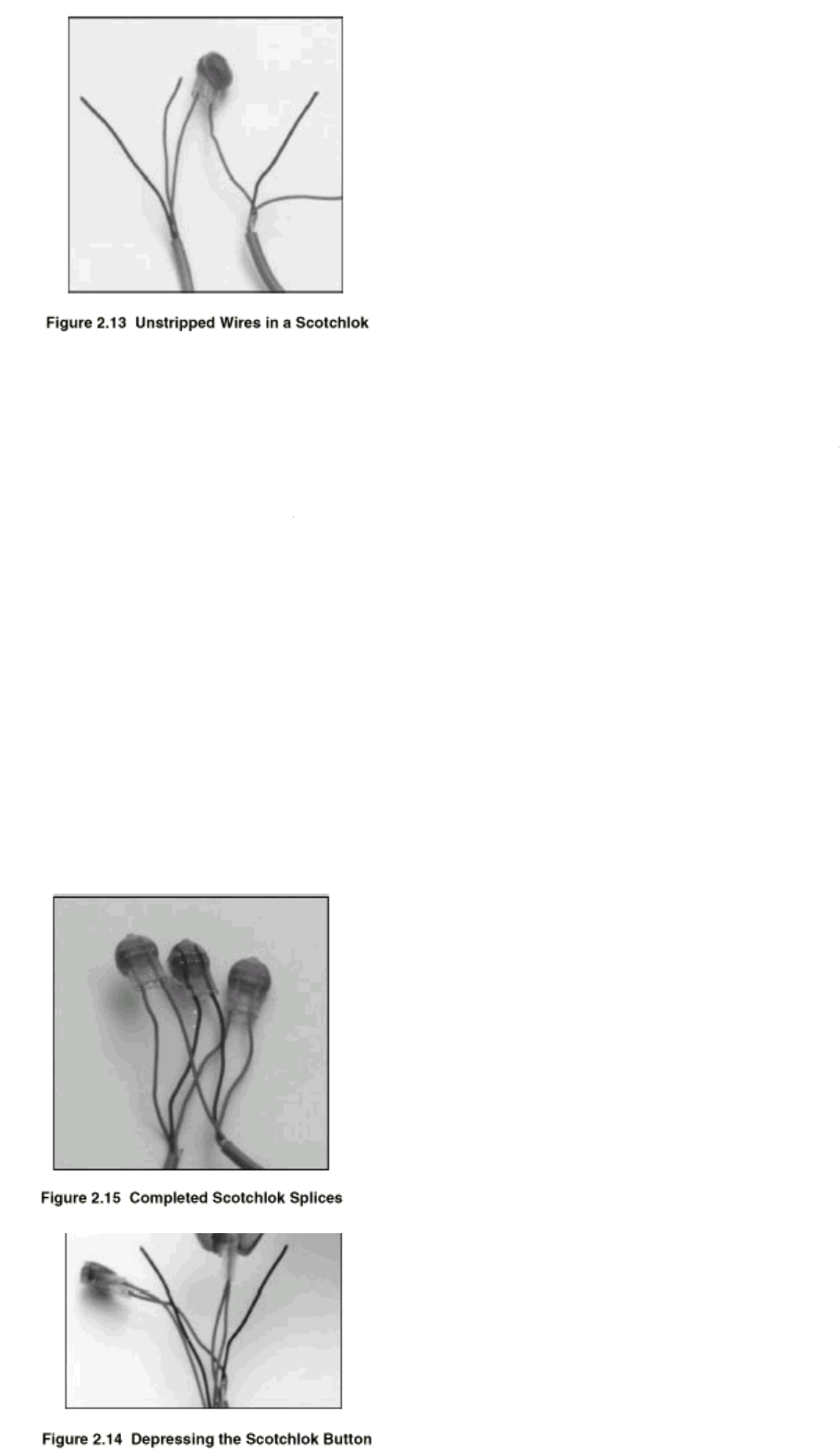
15956 Rev. 0
12/10/98 3:36 PM
15
4 On the three-conductor cable that is to be spliced on, strip off 3/4" of the jacket. Do not strip
the insulation from the individual wires.
5 Match up one pair of colored wires (Black to Black, Green to Green, and Red to Red) and
insert the matching-colored pair into a Scotchlok (Figure 2.13).
Note: If the MIU will be connected to a Pro-Read ® encoder register, the Pro-Read ® must be
programmed for three-wire mode using a Pro-Read ® programmer and its ten-digit TDI format.
Do this through the Pro-Read ® receptacle before removing the receptacle.
6 Using a Scotchlok crimping tool or a pair of Channel locks, squeeze the “button” on the
Scotchlok until it is completely flat (Figure 2.14).
7 Inspect the Scotchlok to verify that both wires are fully inserted. If they are not, redo the splice
(Figure 2.15).
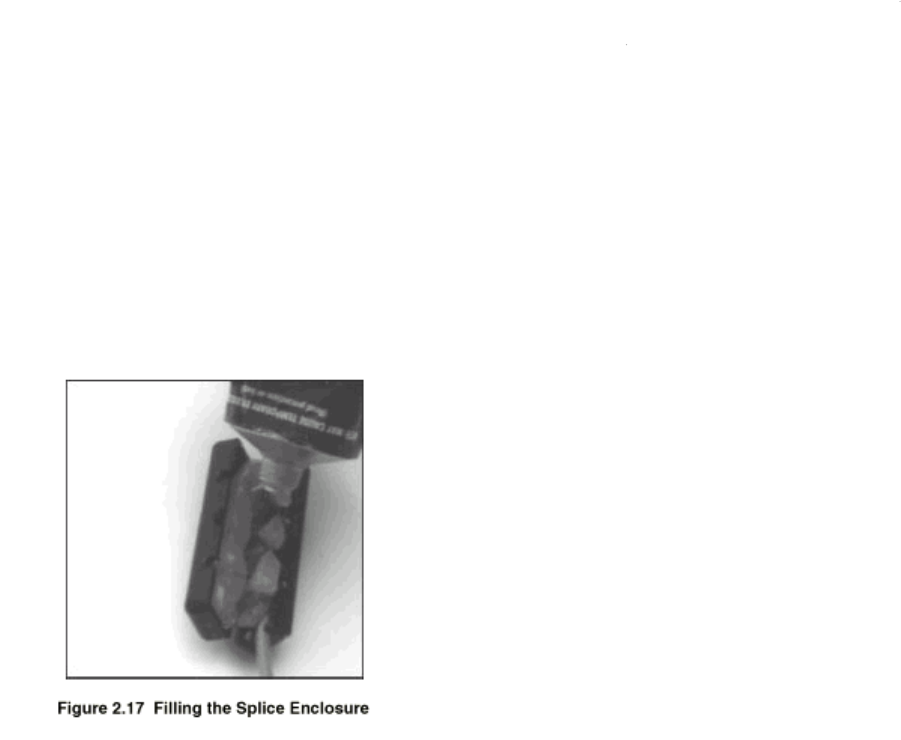
15956 Rev. 0
12/10/98 3:36 PM
16
8 Repeat Steps 5 through 7 for each pair of wires.
9 Tuck the Scotchloks into the splice enclosure and route the cables through the cutouts at the
ends of the splice enclosure (Figure 2.16).
10 Coat the inside of the splice enclosure with Dow Corning #4 ® or GE Novaguard GB24 ®
moisture protection compound (Figure 2.17).
11 Close the splice enclosure, pressing it firmly until the teeth lock together
(Figure 2.18).
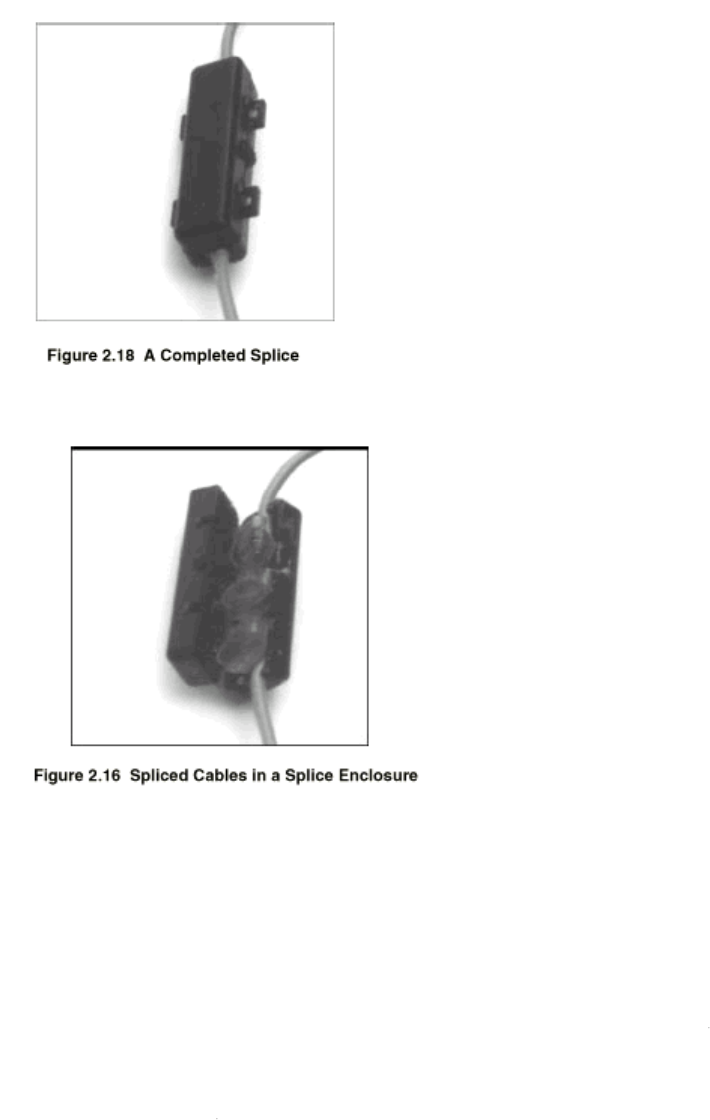
15956 Rev. 0
12/10/98 3:36 PM
17
REPLACING THE BATTERY
Follow these steps to change-out a Wall MIU1’s internal Battery:
1 Unscrew the bolt holding the Main Housing to the Mounting Adapter.
2 Remove the seal wire or seal clip from the Seal Holes at the bottom of the Main Housing.
3 Punch the Tamper Pin out of the Terminal Screw Cover.
4 Remove the Terminal Screw Cover.
5 Remove the wires from the Terminal Screws.
6 Remove the seal wire or seal clip from the Seal Holes at the bottom of the Main Housing.

15956 Rev. 0
12/10/98 3:36 PM
18
7 Using a flat-head screwdriver, gently pry down the clip on the bottom of the Main Housing.
When the clip clears the tab on the Mounting Adapter, pull the Main Housing away from the
Mounting Adapter.
8 Remove the Main Housing by lifting it until it unhinges and comes free from the Mounting
Adapter.
9 Remove the Battery from the Main Housing by pressing in on the left end of the Battery until it
releases and comes free from the Main Housing.
10 As close to the Battery as possible, cut the battery connection wires one at a time.
11 Use gel-caps to splice the wires from the new Battery to the wires that connected to the old
Battery.
12 Snap the Battery into the Receiving Clips on the Main Housing.
13 Install the Main Housing on the Mounting Adapter.
14 Install the appropriate color wires to each Terminal Screw (Black to B, Green to G, Red to R).
15 Follow the steps in “Testing the Installation.”
Note: Cutting the battery connection wires one at a time prevents shorting.
Note: Insure the Wall MIU1’s black wire is connected to ground (-) and the red wire is
connected to the positive (+) wires of the new battery.
SECTION 3
OPERATING INSTRUCTIONS
At the time of installation, the installer uses the CellNet installation tool to verify that the Wall
MIU1 is operating properly. Following the installation, the Wall MIU1 operates automatically
and continuously without any type of human intervention.
SECTION 4
THEORY OF OPERATION
SURF ® MIU Programming
The MIU is not field programmable. At the factory, each of the following items are programmed
into the MIU:
Serial number - Each MIU is given a unique LAN address and a serial number/identification
number. Custom serial numbers are not programmed. The default value is the last programmed
value plus one.
Time between encoder register reads -The time between encoder register reads is set for one
hour.

15956 Rev. 0
12/10/98 3:36 PM
19
Time between MIU transmissions - The time between MIU transmissions is set for
approximately 15 minutes
RF Protocol Error Detection
The RF protocol is comprised of a header, data packet, and an error detection mechanism that
reduces the erroneous data.
RF Transmission Period and Randomness
The random period generation uses the same CellNet ALOHA model to generate the transmit
randomness. The randomness algorithm is defined so that no two consecutive transmissions from
two MIUs will interfere with one another.
Low Battery RF Emissions
The MIU stops RF transmissions when the battery discharges below the normal operating
voltage.
TROUBLESHOOTING
Six-Wheel Encoder Normal Operation
If the odometer reads 123456, the display should be 1 2 3 4 5 5.
Note that the last digit displayed is a five if the last digit on the odometer is five through nine.
The last digit displayed is a zero if the last digit on the odometer is zero through four.
Four-Wheel Encoder Normal Operation
If the odometer reads 123456, the display should be 1 2 3 4 0 0.
Abnormal Operation
Below are examples of abnormal operation for four-wheel encoders. Abnormal operation for six-
wheel encoders is similar except that digit occupy all six positions.
A If an (H) or a ( - ) occurs on any of the four positions, the Wall MIU1 will transmit the data as
follows:
Examples: 1 2 E 4 0 0 or 1 2 b 4 0 0
If the wire between the Wall MIU1 and the encoder is cut or reads as open, the Wall MIU1 will
transmit the following data:
Example: AAAAAA
For three-wire installation, the problem may be in the register, wiring between register and
receptacle, receptacle pins, or the TU-89 pins. If all pins are clean and the wiring is verified to be
good, replace the register.
Example: H H H H - -For three-wire installation, replace the register.
SECTION 5
15956 Rev. 0
12/10/98 3:36 PM
20
TESTING AND MAINTENANCE
After the MIU has been installed and wired, follow these steps to verify that the MIU is working
properly:
1 Activate the MIU by holding the magnet for two seconds against the arrow on the Main
Housing. The arrow is just to the right of the Terminal Screws.
2 Use a CellNet installation tool to verify the transmission from the Wall MIU1.
• Verify all electrical connections.
• Test the installation again.
5 If a Pro-Read ® Encoder Register is used:
• Insure the unit is programmed in “3-wire mode.”
• Verify all electrical connections.
• Reactivate the MIU. (See Step 1)
6 If a problem still exists, refer to Section 5, “Testing And Maintenance.”
15956 Rev. 0
12/10/98 3:36 PM
21
FCC REGULATORY NOTICE
Service Return Address:
Schlumberger RMS, Inc.
1600 Alabama HWY 229 S.
Tallassee, AL 36078
This Wall MIU1 been tested and found to comply with the limits for a Class
B digital device, pursuant to Part 15 of the FCC Rules. These limits are
designed to provide reasonable protection against harmful interference in a
residential installation. This equipment generates, uses and can radiate
radio frequency energy and, if not installed and used in accordance with the
instructions, may cause harmful interference to radio communications.
However, there is no guarantee that interference will not occur in a particular
installation. If this equipment does cause harmful interference to radio or
television reception, which can be determined by turning the equipment off and
on, the user is encouraged to try to correct the interference by one or
more of the following measures:
-- Reorient or relocate the receiving antenna.
-- Increase the separation between the equipment and receiver.
-- Connect the equipment into an outlet on a circuit different from that to which the receiver is connected.
-- Consult the dealer or an experienced radio/TV technician for help.
(c) The provisions of paragraphs (a) and (b) of this section do not apply to digital devices exempted
from the technical standards under the provisions of §15.103.
(d) For systems incorporating several digital devices, the statement shown in paragraph (a) or (b) of
this section needs to be contained only in the instruction manual for the main control unit.
Caution, changes or modifications not expressly approved by the party responsible for compliance could
void the user's authority to operate the equipment.